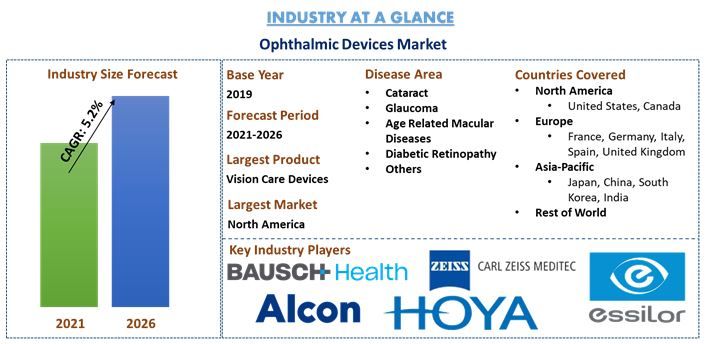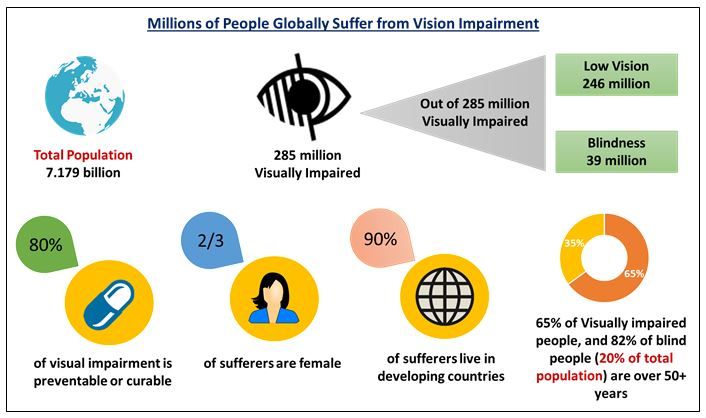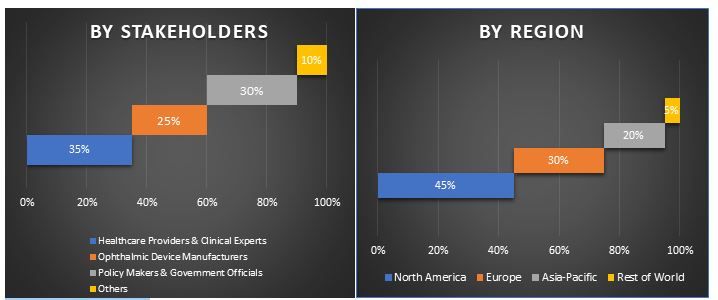- Home
- Chi siamo
- Settore
- Servizi
- Lettura
- Contattaci
Mercato dei dispositivi oftalmici: analisi attuale e previsioni (2020-2026)
Focus sul Prodotto [Vision Care (Occhiali, Lenti a Contatto), Dispositivi Chirurgici (Cataratta, Glaucoma, Refrattiva, Vitreoretinica e Altri Dispositivi Chirurgici), Dispositivi Diagnostici e di Monitoraggio (Tomografo a Coerenza Ottica, Fundus Camera, Tonometro, Perimetro, Biometria Ottica, Microscopi Chirurgici Oftalmici, Lampada a Fessura, Autorefrattori, Altri Dispositivi Diagnostici e di Monitoraggio), Area di Patologia (Cataratta, Glaucoma, Degenerazione Maculare Legata all'Età, Retinopatia Diabetica, Altre), Utenti Finali (Ospedali, Cliniche Oftalmiche, Centri Chirurgici Ambulatoriali, Centri Ottici) e Regione/Paese
I dispositivi oftalmici hanno generato un fatturato di 31.856,4 milioni di dollari nel 2019 e si prevede che raggiungeranno i 46.337,4 milioni di dollari entro il 2026, mostrando un significativo CAGR del 5,2% nel periodo di previsione (2021-2026). Con l'introduzione di dispositivi oftalmici che incorporano queste sofisticate tecnologie, le persone optano sempre più per interventi chirurgici oftalmici per correggere i loro disturbi agli occhi. Un numero crescente di persone riceve protesi oftalmiche a causa dell'invecchiamento della popolazione e della crescente prevalenza di condizioni oftalmiche. Di quelli con disabilità visiva o cecità, le cinque principali condizioni oculari come cataratta, degenerazione maculare, glaucoma, malattia diabetica dell'occhio e difetto di rifrazione rappresentano circa tre quarti di tutti i casi. Negli ultimi anni, la crescita del reddito disponibile ha incoraggiato le persone ad acquistare prodotti di occhialeria di qualità che si integrano perfettamente con i loro crescenti standard di vita. Inoltre, le persone ora optano per occhiali da sole alla moda e di marca secondo le ultime tendenze prevalenti sul mercato.
L'invecchiamento della popolazione è uno dei principali fattori responsabili dell'aumento dell'incidenza e della prevalenza di pazienti affetti da difetti oculari. Le statistiche rivelano che il 65% di coloro che hanno problemi di vista e l'82% di coloro che sono ciechi hanno più di 50 anni. Secondo le Nazioni Unite, l'invecchiamento della popolazione si riferisce al cambiamento nella composizione di una popolazione tale che si verifica un aumento della proporzione di persone anziane. La crescita in alcune regioni e paesi sta rallentando, mentre l'invecchiamento della popolazione sta accelerando. Secondo l'OMS, i cambiamenti nello stile di vita e l'urbanizzazione aumenteranno drasticamente il numero di persone con condizioni oculari, problemi di vista e cecità nei prossimi decenni. La miopia è una di queste condizioni che rappresenta un grave problema di salute pubblica in diversi paesi dell'Asia orientale, dove la condizione colpisce l'80%-90% dei diplomati delle scuole superiori. L'oftalmologia e le sue sottospecialità sono state in prima linea nell'innovazione medica e hanno abbracciato i rapidi progressi in diverse tecnologie, tra cui farmacologia, imaging, elaborazione dati e dispositivi. Le innovazioni tecnologiche in oftalmologia forniscono agli oftalmologi nuovi modi per migliorare la qualità dell'assistenza. I progressi scientifici e tecnologici hanno anche aperto una vasta gamma di opportunità cliniche e di ricerca nel campo della cura degli occhi.
Popolazione affetta da problemi di vista
Essilor International S.A., Bausch Health Companies, Ellex Medical Lasers, Second Sight Medical Products, Hoya Corporation, Alcon, Johnson & Johnson, Carl Zeiss Meditec AG, Escalon Medical Corp., Topcon Corporation, Nidek Co., Staar Surgical, Lumenis, Glaukos Corporation e Vision Care sono alcuni dei principali attori che operano nel mercato globale dei dispositivi oftalmici. Diversi M&A insieme a partnership sono stati intrapresi da questi attori per facilitare i clienti con prodotti hi-tech e innovativi.
Approfondimenti presentati nel rapporto
"Tra i tipi di prodotto, il segmento dei dispositivi per la cura della vista detiene la quota maggiore"
In base al tipo di prodotto, il mercato è frammentato in dispositivi per la cura della vista, dispositivi chirurgici e diagnostica e monitoraggio. I dispositivi per la cura della vista hanno dominato il mercato con una quota del 79,2% nel 2019 e si prevede che manterranno il loro predominio durante il periodo di previsione a causa del crescente utilizzo di dispositivi elettronici come telefoni cellulari, PC e laptop, che si traducono in vari difetti correlati agli occhi.
"Tra i prodotti per la cura della vista, il sottosegmento degli occhiali ha dominato il mercato nel 2019"
Il segmento della cura della vista è ulteriormente suddiviso in occhiali e lenti a contatto. Gli occhiali hanno dominato il mercato con una quota dell'81,6% nel 2019 e si prevede che manterranno il loro predominio durante il periodo di previsione a causa dell'età crescente, probabilmente dovuta alla maggiore necessità di correzione refrattiva presbiopica e post-chirurgia della cataratta. Anche l'uso corrente di occhiali è aumentato con l'aumentare dello status socioeconomico, probabilmente correlato al maggiore livello di istruzione. Tuttavia, si prevede che il segmento delle lenti a contatto assisterà al CAGR più elevato durante il periodo di previsione (2021-2026).
"Tra i segmenti dei dispositivi chirurgici, si prevede che il segmento dei dispositivi per la chirurgia della cataratta dominerà il mercato durante il periodo analizzato"
Sulla base dei dispositivi chirurgici, il mercato è suddiviso in dispositivi per la chirurgia della cataratta, dispositivi per la chirurgia del glaucoma, dispositivi per la chirurgia refrattiva, dispositivi per la chirurgia vitreoretinica e altri dispositivi chirurgici. I dispositivi per la chirurgia della cataratta hanno dominato il mercato con una quota del 66,8% nel 2019 e si prevede che manterranno il loro predominio durante il periodo di previsione a causa della procedura chirurgica più frequente eseguita in molti paesi sviluppati, fornendo miglioramenti significativi, a lungo termine ed economici nella qualità della vita per pazienti di tutte le età. Tuttavia, si prevede che i dispositivi per la chirurgia del glaucoma assisteranno al CAGR più elevato durante il periodo analizzato.
"Tra i tipi di dispositivi oftalmici di diagnostica e monitoraggio, la tomografia a coerenza ottica/oftalmoscopia laser a scansione ha dominato il mercato nel 2019"
In base al tipo di dispositivi oftalmici di diagnostica e monitoraggio, il mercato è segmentato in tomografia a coerenza ottica/oftalmoscopia laser a scansione, fundus camera, tonometro, perimetro, biometria ottica, microscopi operatori oftalmici, lampada a fessura, autorefrattori e altri dispositivi diagnostici e di monitoraggio. Nel 2019, la tomografia a coerenza ottica/oftalmoscopia laser a scansione ha rappresentato il 18% della quota di entrate del mercato e ha dominato il mercato. Il segmento è più comunemente utilizzato nella clinica per diagnosticare le malattie della retina. L'OCT è diventato essenziale in oftalmologia, offrendo una risoluzione superiore della retina e di alcuni dei tessuti adiacenti per la diagnosi e il trattamento delle malattie degli occhi. Nuove modalità OCT sono state ora assimilate all'oncologia oftalmica per aiutare a tenere traccia dello stato dei tumori oculari e perioculari attraverso i sintomi della retina.
"Tra le aree di malattia, si prevede che la cataratta dominerà il mercato durante il periodo analizzato"
Sulla base dell'area di malattia, il mercato è frammentato in cataratta, glaucoma, degenerazione maculare legata all'età, retinopatia diabetica e altri. Nel 2019, la cataratta ha rappresentato la quota di mercato massima con il 28,5% e si prevede che sarà il segmento leader del mercato dei dispositivi oftalmici durante il periodo di previsione. Secondo l'ultima valutazione dell'OMS, la cataratta è responsabile di circa il 51% della cecità mondiale, che rappresenta circa 20 milioni di persone. Sebbene le cataratte possano essere rimosse chirurgicamente, esistono barriere in molti paesi che impediscono ai pazienti di accedere alla chirurgia. Tuttavia, si prevede che la retinopatia diabetica assisterà alla crescita del CAGR più elevato durante il periodo di previsione 2021-2026.
"Tra gli utenti finali, i centri ottici hanno dominato il mercato nel 2019"
Sulla base degli utenti finali, il mercato dei dispositivi oftalmici è frammentato in centri ottici, ospedali, cliniche oftalmiche e centri di chirurgia ambulatoriale. Nel 2019, i centri ottici hanno rappresentato il 47,2% della quota di entrate del mercato e hanno dominato il mercato. Tuttavia, si prevede che il segmento delle cliniche oftalmiche assisterà al CAGR più elevato durante il periodo di previsione.
"Il Nord America rappresenta uno dei mercati più grandi del mercato dei dispositivi oftalmici"
Per una migliore comprensione delle dinamiche di mercato del mercato dei dispositivi oftalmici, è stata condotta un'analisi dettagliata per diverse regioni in tutto il mondo, tra cui Nord America (USA, Canada e resto del Nord America), Europa (Germania, Regno Unito, Francia, Italia, Spagna e resto d'Europa), Asia-Pacifico (Cina, Giappone, India, Corea del Sud e resto dell'Asia-Pacifico) e il resto del mondo. Il Nord America ha dominato il mercato e ha generato entrate per 10.826,2 milioni di dollari nel 2019 a causa della crescente prevalenza di disturbi oculari, della crescita della popolazione geriatrica, dell'aumento della spesa sanitaria e dei progressi tecnologici nei dispositivi oftalmici. Circa 11 milioni di americani di età pari o superiore a 12 anni potrebbero migliorare la propria vista attraverso una corretta correzione refrattiva.
Motivi per acquistare questo rapporto:
- Lo studio include analisi di dimensionamento e previsione del mercato convalidate da esperti chiave del settore autenticati
- Il rapporto presenta una rapida revisione delle prestazioni complessive del settore a colpo d'occhio
- Il rapporto copre un'analisi approfondita dei principali concorrenti del settore con un focus primario sui principali dati finanziari aziendali, portafoglio prodotti, strategie di espansione e sviluppi recenti
- Esame dettagliato di driver, vincoli, tendenze chiave e opportunità prevalenti nel settore
- Lo studio copre in modo completo il mercato in diversi segmenti
- Analisi approfondita a livello regionale del settore
Opzioni di personalizzazione:
Il mercato dei dispositivi oftalmici può essere ulteriormente personalizzato in base ai requisiti o a qualsiasi altro segmento di mercato. Inoltre, UMI comprende che potresti avere le tue esigenze aziendali, quindi sentiti libero di metterti in contatto con noi per ottenere un rapporto che si adatti completamente alle tue esigenze.
Indice
L'analisi del mercato storico, la stima del mercato attuale e la previsione del mercato futuro del mercato globale dei dispositivi oftalmici sono stati i tre passaggi principali intrapresi per creare e analizzare l'adozione di dispositivi oftalmici in vari settori verticali in importanti regioni a livello globale. È stata condotta un'esaustiva ricerca secondaria per raccogliere i dati storici di mercato e stimare le dimensioni del mercato attuale. In secondo luogo, per convalidare queste intuizioni, sono state prese in considerazione numerose scoperte e ipotesi. Inoltre, sono state condotte anche approfondite interviste primarie con esperti del settore lungo tutta la catena del valore del settore dei dispositivi oftalmici. Dopo l'ipotesi e la convalida dei dati di mercato attraverso interviste primarie, abbiamo impiegato un approccio top-down per prevedere le dimensioni complete del mercato. Successivamente, sono stati adottati metodi di scomposizione del mercato e triangolazione dei dati per stimare e analizzare le dimensioni del mercato dei segmenti e sottosegmenti a cui appartiene il settore. La metodologia dettagliata è spiegata di seguito:
Analisi delle dimensioni storiche del mercato
Fase 1: Studio approfondito delle fonti secondarie:
È stato condotto uno studio secondario dettagliato per ottenere le dimensioni storiche del mercato dei dispositivi oftalmici attraverso fonti interne aziendali come relazioni annuali e bilanci, presentazioni sulle prestazioni, comunicati stampa, ecc., e fonti esterne tra cui riviste, notizie e articoli, pubblicazioni governative, pubblicazioni della concorrenza, relazioni di settore, database di terze parti e altre pubblicazioni credibili.
Fase 2: Segmentazione del mercato:
Dopo aver ottenuto le dimensioni storiche del mercato dei dispositivi oftalmici, abbiamo condotto un'analisi secondaria dettagliata per raccogliere informazioni storiche sul mercato e condividere diversi segmenti e sottosegmenti per le principali regioni. I segmenti principali inclusi nel rapporto come prodotto, area di malattia e utente finale. Sono state condotte ulteriori analisi a livello di paese per valutare l'adozione complessiva dei dispositivi oftalmici in quella regione.
Fase 3: Analisi dei fattori:
Dopo aver acquisito le dimensioni storiche del mercato di diversi segmenti e sottosegmenti, abbiamo condotto una dettagliata analisi dei fattori per stimare le dimensioni attuali del mercato dei dispositivi oftalmici. Inoltre, abbiamo condotto un'analisi dei fattori utilizzando variabili dipendenti e indipendenti come la crescita della crescente prevalenza delle malattie degli occhi e l'accelerazione della popolazione geriatrica. È stata condotta un'analisi approfondita dello scenario della domanda e dell'offerta considerando le principali partnership, fusioni e acquisizioni, espansioni aziendali e lanci di prodotti nel settore dei dispositivi oftalmici in tutto il mondo.
Stima e previsione delle dimensioni attuali del mercato
Dimensionamento del mercato attuale: Sulla base di informazioni utili dai 3 passaggi precedenti, siamo giunti alle dimensioni attuali del mercato, ai principali attori nel mercato dei dispositivi oftalmici e alle quote di mercato dei segmenti. Tutte le quote percentuali richieste e le suddivisioni del mercato sono state determinate utilizzando l'approccio secondario sopra menzionato e sono state verificate attraverso interviste primarie.
Stima e previsione: Per la stima e la previsione del mercato, sono stati assegnati pesi diversi a diversi fattori, tra cui driver e tendenze, vincoli e opportunità disponibili per le parti interessate. Dopo aver analizzato questi fattori, sono state applicate le tecniche di previsione pertinenti, ovvero l'approccio top-down, per arrivare alla previsione di mercato intorno al 2026 per diversi segmenti e sottosegmenti nei principali mercati a livello globale. La metodologia di ricerca adottata per stimare le dimensioni del mercato comprende:
- Le dimensioni del mercato del settore, in termini di valore (US$) e il tasso di adozione dei dispositivi oftalmici nei principali mercati
- Tutte le quote percentuali, le suddivisioni e le ripartizioni dei segmenti e sottosegmenti di mercato
- I principali attori nel mercato dei dispositivi oftalmici in termini di servizi offerti. Inoltre, le strategie di crescita adottate da questi attori per competere nel mercato in rapida crescita
Convalida delle dimensioni e della quota di mercato
Ricerca primaria: Sono state condotte interviste approfondite con i Key Opinion Leaders (KOL) tra cui dirigenti di alto livello (CXO/VP, responsabile vendite, responsabile marketing, responsabile operativo e responsabile regionale, responsabile paese, ecc.) nelle principali regioni. I risultati della ricerca primaria sono stati quindi riassunti ed è stata eseguita un'analisi statistica per dimostrare l'ipotesi dichiarata. I contributi della ricerca primaria sono stati consolidati con i risultati secondari, trasformando quindi le informazioni in informazioni fruibili.
Ripartizione dei partecipanti primari in diverse regioni
Ingegneria del mercato
È stata impiegata la tecnica di triangolazione dei dati per completare la stima complessiva del mercato e per arrivare a precisi dati statistici di ogni segmento e sottosegmento del mercato dei dispositivi oftalmici. I dati sono stati suddivisi in diversi segmenti e sottosegmenti dopo aver studiato vari parametri e tendenze nelle aree di prodotto, area di malattia e utenti finali del mercato dei dispositivi oftalmici.
L'obiettivo principale dello studio sul mercato dei dispositivi oftalmici
Le tendenze attuali e future del mercato dei dispositivi oftalmici sono state individuate nello studio. Gli investitori possono ottenere informazioni strategiche su cui basare la propria discrezione per gli investimenti dall'analisi qualitativa e quantitativa eseguita nello studio. Le tendenze di mercato attuali e future hanno determinato l'attrattiva complessiva del mercato a livello regionale, fornendo una piattaforma per il partecipante industriale per sfruttare il mercato non sfruttato a vantaggio di un vantaggio di first-mover. Altri obiettivi quantitativi degli studi includono:
- Analizzare le dimensioni attuali e previste del mercato dei dispositivi oftalmici in termini di valore (US$). Inoltre, analizzare le dimensioni attuali e previste del mercato di diversi segmenti e sottosegmenti
- I segmenti nello studio includono aree di prodotto, area di malattia e utenti finali
- Analisi definita del quadro normativo per l'industria dei dispositivi oftalmici
- Analizzare la catena del valore coinvolta con la presenza di vari intermediari, insieme all'analisi del comportamento dei clienti e dei concorrenti del settore
- Analizzare le dimensioni attuali e previste del mercato dei dispositivi oftalmici per le principali regioni
- Le principali regioni studiate nel rapporto includono Nord America (Stati Uniti, Canada e Resto del Nord America), Europa (Germania, Francia, Italia, Spagna, Regno Unito e Resto d'Europa), Asia-Pacifico (Cina, Giappone, India, Corea del Sud e Resto dell'APAC) e Resto del mondo
- Profili aziendali degli attori del mercato dei dispositivi oftalmici e le strategie di crescita adottate da questi per sostenersi nel mercato in rapida crescita
- Analisi approfondita a livello regionale del settore
Correlati Report
I clienti che hanno acquistato questo articolo hanno acquistato anche













